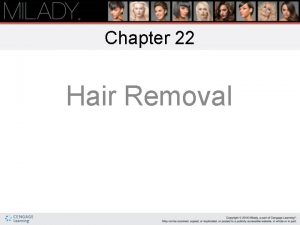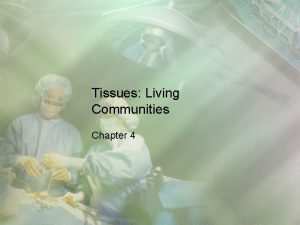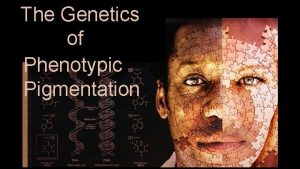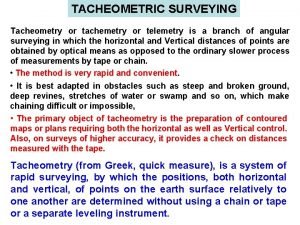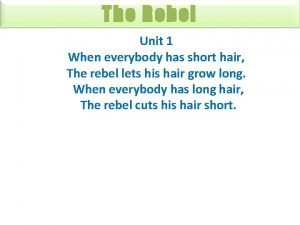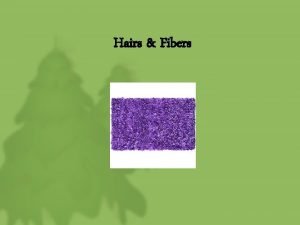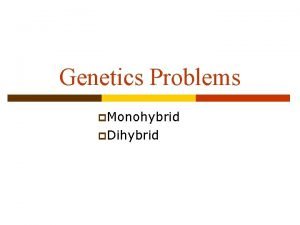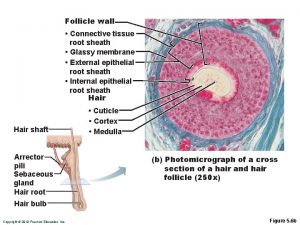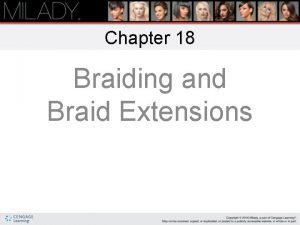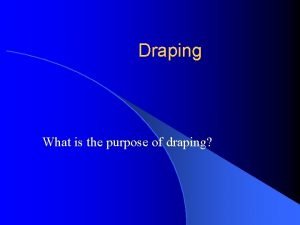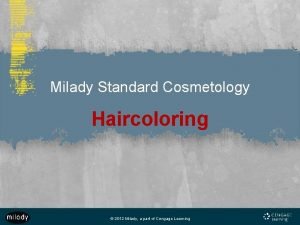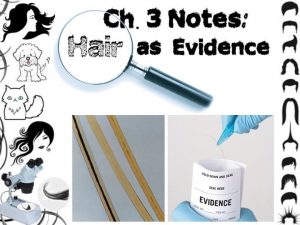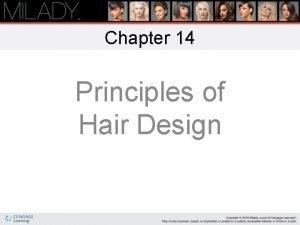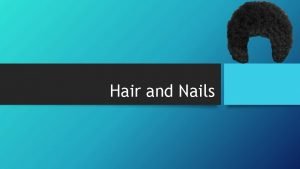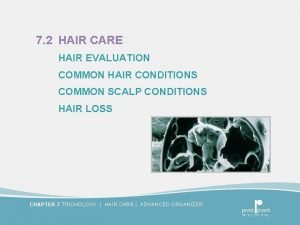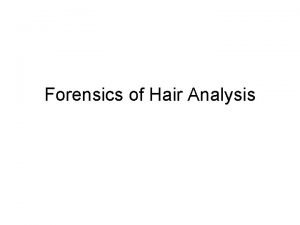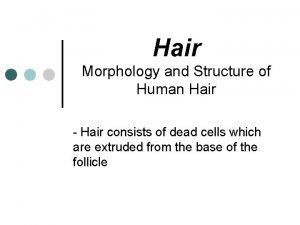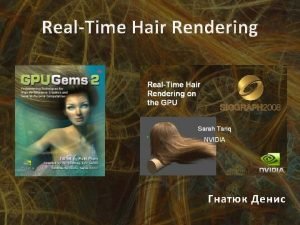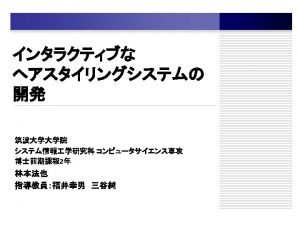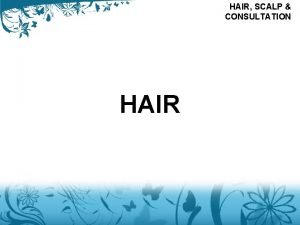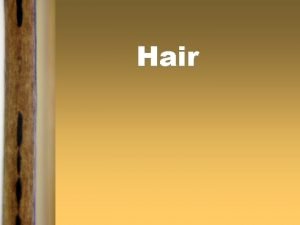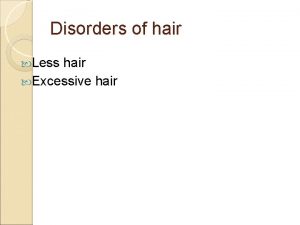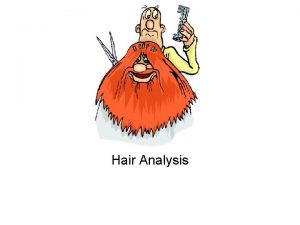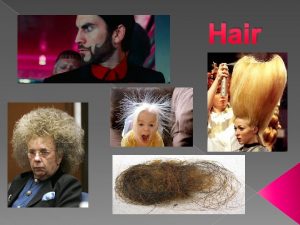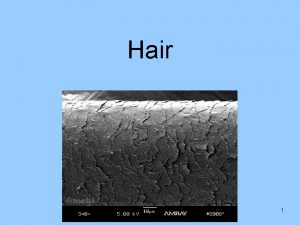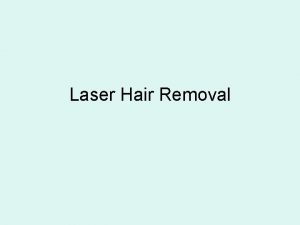The Importance of Hair 1 Most common type



























- Slides: 27

The Importance of Hair 1) Most common type of trace evidence found at crime scenes, along with fibers Locard's Principle: there is always a cross transfer of evidence between suspect, victim and scene

Importance of Hair 2) Hair is class evidence and can be used to • corroborate other circumstantial evidence • narrow the list of suspects • detect poison and drugs 3) Hair is very resistant to decomposition

Hair Basics 1) Adult human body has an average 5 million hairs – – most are fine, downy-like hair (villus) that covers the body blonds have ~ 120, 000 scalp hairs red heads ~ 80, 000 scalp hairs black - brown hair ~ 100, 000 scalp hairs 2) Hair on scalp is continuously shed and renewed at a rate of ~100 each 24 hours 3) Hair grows from an organ in the skin called the follicle 4) Each follicle has a supply of blood via capillaries 5) Substances in the blood stream are distributed to hair growing at the time

Diagram of Hair in Follicle

Hair Composition Hair is composed of a tough protein called Keratin – made of amino acid subunits (polymer) – primarily the amino acid cystine, which contains sulfur – Chemical bonds between cystine molecules strengthen the protein

Parts of Hair 1) Root or bulb: proximal end of hair that is embedded in the follicle 2) Shaft: part of hair extending above the skin 3) Tip: distal end of hair

Cross Section of Hair

Cuticle a) Clear, outer covering of the shaft b) Made of overlapping scales c) Scales always point toward tip(distal end) d) Pattern of scales is used to identify species e) Three patterns: 1. coronal (crown-like) 2. spinous (petal-like) 3. imbricate (flat cracks) imbricate Spinous coronal

Cortex a) largest portion of the shaft b) made of keratin protein molecules aligned parallel to length of shaft c) contains pigment called melanin d) melanin varies in color, shape and distribution e) absence of pigments = gray or white color hair f) cortical fusi are sacs of air in cortex g) size and shape of cortical fusi provide class characteristics

Medulla a) row of cells, like a canal in the center of cortex b) may be dark or translucent, depending on whethere is air, liquid or pigments c) medulla patterns 1) Continuous: no breaks, common in Native Americans and Asians 2) Interrupted: even breaks 3) Fragmented: uneven breaks 4) Absent: most common pattern in humans

Longitudinal Section of Hair

Types of Cuticles 1) Coronal Cuticle – crown-like scales, resembling stacks of cup – found in hairs of very fine diameter – commonly found: rodent and bat hair – rarely found: human hair 2) Spinous Cuticle – petal-like scales – triangular in shape – Found: mink, seals, cats – never found on humans 3) Imbricate Cuticle – flattened scales – overlapping scales with irregular margins – commonly found: human and other animals

Hair Shapes

Tip of the Shaft Burned Cut Razored Split

General Rules a) Asians & Native Americans have round shape, no twisting b) Africans have flat to crescent shape with undulating or twisting; densely clumped pigmentation c) Americans, Europeans, Mexicans, Middle Easterners have an oval shape, rarely twisting or undulating; evenly distributed fine pigmentation

Hair Growth 1. Coarse hairs grow at a slower rate and falls out less frequently than finer hair 2. Grows ~ 1 cm/month (0. 33 mm /day) 3. Hair is replaced every 3 -6 years with a new hair

Anagen Phase (growth phase) • lasts up to 6 years (genetically determined) • 80 -90% of hair is in this phase • around the dermal papilla is the hair matrix, a collection of rapidly dividing epithelial cells that produce the hair shaft • root of hair has a flame shape appearance and is attached to follicle • hair pulled out during this phase will have a sheath of tissue around the root called a "follicular tag, " which contains DNA

Catagen Phase (intermediate phase) • lasts ~ 3 weeks • end of active hair growth • hair follicle shrinks to about 1/6 of the normal length • the dermal papilla breaks away, the bulb detaches from the blood supply and the hair shaft is pushed up as the follicle disintegrates • root shrinks in diameter and has an elongated shape

Telogen Phase (follicle resting phase) • lasts 2 -6 months • 8 -10% of hair • hair is not growing, but remains attached to the follicle while the dermal papilla is in a resting phase below • naturally shed hair has a club shape root




Forcibly Removed? • Pulled Forcibly Removed Shed

Brushed-out hairs all have this kind of root. A normal telogen hair with a hard 'club' end, seen under (left) a light microscope and (right) an electron microscope This is an anagen hair, one which was pulled out and not ready to be shed. An anagen hair that has been plucked out: notice the soft, sticky tail

Collection of Hair Evidence A. Visibly observed hairs collected by hand, tweezers are not recommended in most cases, because they can damage hair B. Infrared light or lasers may be used to visually identify non-visible hairs C. Clear tape can be used in either roller form or sheet to lift both visible and non-visible hair D. Vacuuming method of collection is used for large crime scenes where the most likely points of transfer are unknown E. Garments may be brushed, scraped or shook over white paper or cloth F. Garment may be placed in a bag and shook, so that hair can be collected from the bottom of the bag

Collection of Exemplars A. Anyone who may have left hair at the crime scene should be sampled for comparison purposes. B. Approximately 50 scalp hairs from various areas of the head should be pulled (anagen) and combed (telogen). C. For body hair, 30 - 50 hairs should be collected and labeled as to their origin. D. As a matter of routine, hair samples are collected from the victim of suspicious death during an autopsy.

Quiz #1 1) 2) 3) 4) What is the average number of hair on an adult? Hair is shed at a rate of ______ every 24 hours. Name the primary amino acid in hair. List the parts of a cross section of hair from inside to outside. 5) Draw an interrupted medulla. 6) What kind of cross sectional shape creates wavy hair?
 Milady chapter 22
Milady chapter 22 Cirrus clouds are composed primarily of
Cirrus clouds are composed primarily of What does structure fits function mean
What does structure fits function mean Most common blood type for caucasian
Most common blood type for caucasian What is this called
What is this called Which is the most common type of precipitation?
Which is the most common type of precipitation? The most common type of plant fiber is
The most common type of plant fiber is The most common type of bullying
The most common type of bullying Dark hair and blonde hair parents
Dark hair and blonde hair parents Uses of tacheometry
Uses of tacheometry When everybody has short hair
When everybody has short hair Hair grows in diagonal tubes called hair
Hair grows in diagonal tubes called hair Scale pattern of human hair
Scale pattern of human hair Heterozygous short-hair x heterozygous short-hair
Heterozygous short-hair x heterozygous short-hair Hair follicle and hair bulb
Hair follicle and hair bulb The two primary parts of hair are the hair fiber and the
The two primary parts of hair are the hair fiber and the Name and describe several textured sets and styles
Name and describe several textured sets and styles Where did lorraine hansberry go to college
Where did lorraine hansberry go to college Highest common factor of 12 and 42
Highest common factor of 12 and 42 Common anode and common cathode
Common anode and common cathode 56 prime factorization
56 prime factorization Factors of 54
Factors of 54 Gcf of 72 and 90
Gcf of 72 and 90 Highest common factors and lowest common multiples
Highest common factors and lowest common multiples Hair draping meaning
Hair draping meaning Preliminary strand test
Preliminary strand test Difference between animal and human hair
Difference between animal and human hair What are the 5 principles of hair design
What are the 5 principles of hair design
